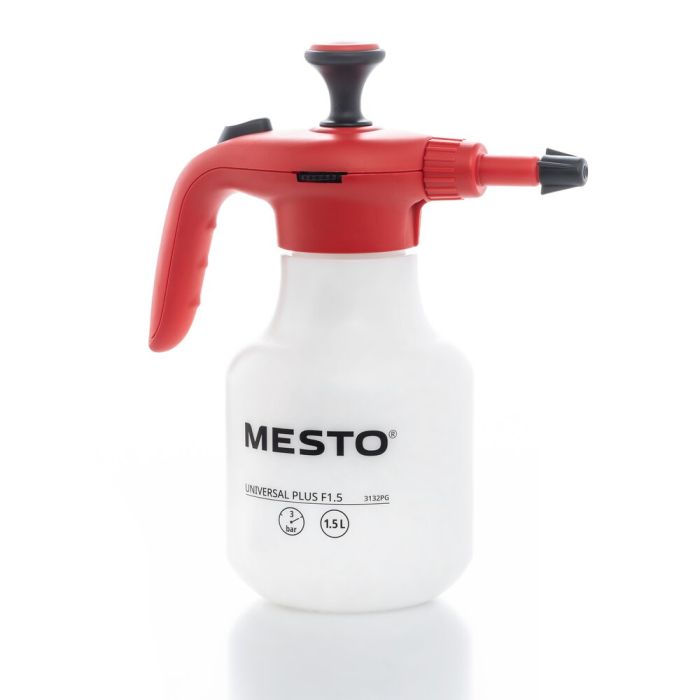UNIVERSAL PLUS F1.5 pressure sprayer
Pressure sprayer 1.5 l for use in the cleaning trade, for disinfection, vehicle cleaning, corrosion protection, impregnation.
The pressure sprayer has a fill capacity of 1.5 l, is made of plastic and features a level scale and a safety valve. FPM seals provide excellent resistance to many cleaning agents. The nozzle is adjustable and also made of plastic. The closed pump head protects against dirt.
Application: ph value 4 - 7
Ideal for: Cleaning trade, industry - vehicle cleaning, disinfection, corrosion protection, impregnation
| Custom Label | Customer favorite |
|---|---|
| Product class | Profi *** |
| Spraying agents | Impregnating agents, Oily agents, Acid detergents, Acid disinfectants |
| Product label | Kundenliebling |
| EAN | 4000903313234 |
| Fill capacity | 1.5 l |
| Total contents | 1.7 l |
| Weight | 0,48 Kg |
| Article type | Pressure sprayers |
| Industry | Trade, Cleaning, Industry |
| Applications | Disinfecting, Impregnating, Cleaning, Lubricating, Pre-wetting |
| Max. operating pressure | 3 bar/44 psi/0.3 MPa |
| Tank material | Plastic transparent |
| Portability | hand portable |
| Nozzle type | Adjustable: Spot to full jet, Spray nozzle |
| Nozzle material | Plastic |
| Spray wand material | Plastic |
| Spray wand length | 5 cm |
| Safety valve | ja |
| Pressure gauge | without |
| Compressed air filler valve | no |
| Scope of delivery general | tank, Nozzle(s), Instructions for use, Pump, Spray wand |
| Device equipment | Extra large filler opening for simple filling., Embossed level scale to monitor the level at all times., Completely enclosed spray head is easy to clean and protects against malfunctioning due to contamination., 2 in 1 valve enables automatic pressure release in case of overpressure and manual pressure release, if required., Ergonomic handle for comfortable working., Adjustable nozzle from spot jet to fine, even atomization. |
Select the desired download.

| Type | Description | File extension | File size |
|---|
If you miss a download, please write us via our contact form.
Please contact the respective seller directly to check whether the item is still available.
Devices may not be used for spraying plant protection liquids.
Only trained, healthy and rested people may work with the device. You should not be under the influence of alcohol, drugs or medication.
Children and adolescents must not use the device. Keep the spraying devices safe from access to children.
Take precautions to prevent hazardous substances from being misused.
→ Accident risk!
Keep bystanders away during spraying.
Never spray on people, animals, electrical devices and lines, into the wind, or into bodies of water.
→ Risk of injury!
Wear appropriate protective clothing, goggles and respiratory protection in line with the applicable national regulations when working with hazardous substances.
Avoid ignition sources in the environment.
Do not allow the device to remain under pressure and/or exposed directly to sunlight. Make certain the device is not heated beyond the maximum operating temperature. (→Table 1).
Protect the device from frost and ammonia.
Never blow through the nozzles or valves with your mouth.
→ Risk of poisoning!
There is a risk of slipping or tripping on smooth or wet surfaces, snow, ice, on slopes and on uneven terrain.
Repairs and modifications to the device are not permitted. Have damaged parts or parts that do not work properly repaired immediately by our customer service department or by service partners authorized by us.
The effect of the safety valve must not be bypassed or made inoperative.
→ Explosion hazard!
Use only original spare and accessory parts. We cannot assume any liability resulting from the use of third-party parts.
When pumping, always observe the pressure gauge to ensure the maximum
spraying pressure is not exceeded (→ Table 1).
All excess pressure must be released from the device before filling, after use, before carrying out maintenance work, on work breaks, and before placing it in storage.
Points to note when transporting the device: Transport the device in such a way that it is protected against damage and tipping. All excess pressure must be released from the device.
→ Explosion hazard!
If the device leaks at the container, immediately depressurise the device and put it out of operation!
→ Risk of explosion!















